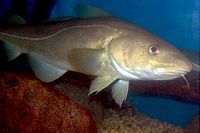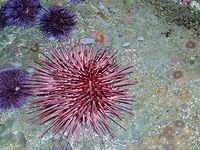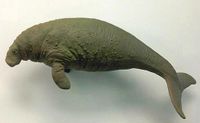Trophic cascade
Definition of Trophic cascade:
Effects of removal or addition of keystone species that propagate through food webs across multiple trophic levels.
This is the common definition for Trophic cascade, other definitions can be discussed in the article
|
Contents
Keystone species
It can happen that a single species, or just a few species, play a crucial role in maintaining the structure of an ecological community and in determining the types and numbers of various other species in the community. Such species are called keystone species. Ecosystems ruled by keystone species are often ecosystems where the species diversity and the diversity of predator-prey relationships within the food web are modest or low. Disappearance of a keystone species often results in a complete rearrangement of the food web. This is referred to by the term trophic cascade. If the keystone species is at the top of the food chain, the disappearance of this top predator can cause a top-down trophic cascade. If the keystone species is at the base of the food chain, the disappearance of this species can lead to a bottom-up trophic cascade. A trophic cascade can also result from a strong increase in the abundance of a keystone species.
Regime shift
A regime shift is an abrupt persistent shift in ecosystem state (structure) and ecosystem function in response to a small disturbance (i.e., relatively small compared to the ecosystem shift), see the article Ecological thresholds and regime shifts. Examples of regime shifts by a trophic cascade are less common in the marine environment than in the freshwater environment, probably due to the greater biodiversity in the former case (Frank et al., 2005[1]). Marine ecosystems in general recover when the disturbance that caused the elimination of the keystone species and the trophic cascade is removed (comeback of the keystone species). However, this is not always the case as illustrated by the example of the Atlantic cod.
The Atlantic cod example
An example of a top-down cascade refers to the collapse of several large predatory fish species in the eastern Scotian Shelf off Nova Scotia, Canada, during the mid-1980s and early 1990s (Frank et al., 2005[1]). It is generally believed that overfishing in this period is the cause of the collapse of the cod population and the decline of other predatory fishes such as haddock, hake, pollock, cusk, redfish, plaice, yellowtail, flounder and skate. The decline of these tertiary consumers coincided with a sharp increase in their former prey: small pelagic fishes and benthic macroinvertebrates such as snow crab and shrimp. These secondary consumers mainly hunt for large zooplankton, resulting in a shift from large to small zooplankton species. The decline of the large primary consumers allowed for an increase of the phytoplankton abundance, which was also reflected in a decrease in the nitrate concentration, the main limiting nutrient. The great beneficiaries of this ecosystem shift were the seals that were freed from food competition with the predatory fish. Fisheries also benefited, because the shrimp and crab catch provided a better economic yield than the groundfish fishery. The cod population has not recovered since. A major cause is probably the strong increase in the population of seals, which exert a high predation pressure on the cod population. The increase in the abundance of smaller pelagic fish did play a role as well, because of their predation on cod larvae (Neuenhoff et al., 2019[2]). Reduction of fishing pressure did not result in a recovery of the cod population. A short period of overfishing, that reduced the cod population below a critical level, caused a long-lasting large-scale regime shift.
The otter-kelp example
Another frequently cited example of a trophic cascade involves the sea otter-kelp ecosystem of the rocky reefs of the Aleutian Islands in the North Pacific Ocean. In this ecosystem, the sea otter is the keystone species with sea urchins as its main food source. Sea urchins graze kelp, the abundance of which is inversely related to the abundance of sea urchins. When the sea otter population of the Commander Islands (the westernmost of the Aleutian Islands) was practically wiped out by human hunting in the eighteenth century, the population of sea urchins increased so much that it led to a decimation of the kelp forests (Estes and Palmisano, 1974[3]). The reintroduction of the sea otter and the cessation of hunting by humans subsequently led to the recovery of the kelp forests. In this case the regime shift did not persist after elimination of the disturbance. However, there is evidence that the decline of the kelp stock has contributed to the starvation and finally extinction of the herbivorous Steller's see cow, which therefore probably cannot be attributed solely to human hunting of this animal (Estes et al., 2016[4]).
See also
Wikipedia article Trophic cascade
Related articles
- Overexploitation
- Effects of fisheries on marine biodiversity
- Ecological thresholds and regime shifts
- Resilience and resistance
- Species extinction
- Disturbances, biodiversity changes and ecosystem stability
References
- ↑ 1.0 1.1 Frank, K.T., Petrie, B., Choi, J.S. and Leggett, W.C. 2005. Trophic Cascades in a Formerly Cod-Dominated Ecosystem. Science 308: 1621-1623
- ↑ Neuenhoff, R.D., Swain, D.P., Cox, S.P., McAllister, M.K., Trites, A.W., Walters, C.J. and Hammill, M.O. 2019. Continued decline of a collapsed population of Atlantic cod (Gadus morhua) due to predation-driven Allee effects. Can. J. Fish. Aquat. Sci. 76: 168–184
- ↑ Estes, J.A. and Palmisano, J.F. 1974. Sea otters: their role in structuring nearshore communities. Science 185(4156): 1058–1060
- ↑ Estes, J.A., Burdin, A. and Doak, D.F. 2016. Sea otters, kelp forests, and the extinction of Steller’s sea cow. PNAS 113: 880–885
Please note that others may also have edited the contents of this article.
|




